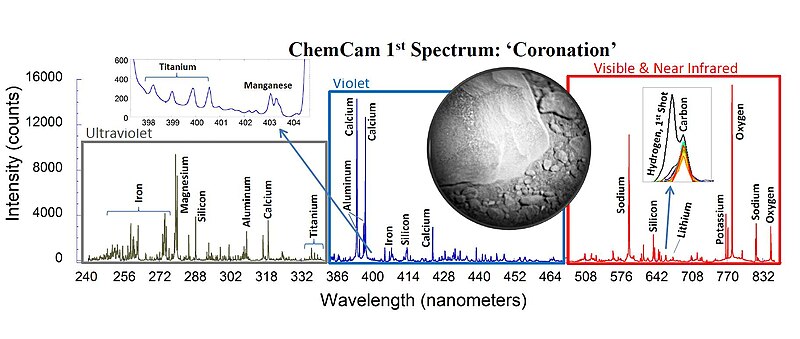File:PIA16089.jpg

Original file (1,826 × 774 pixels, file size: 163 KB, MIME type: image/jpeg)
Captions
Captions
Summary
[edit]| DescriptionPIA16089.jpg |
English: 08.22.2012
Coronation's Chemicals This is the first laser spectrum from the Chemistry and Camera (ChemCam) instrument on NASA's Curiosity rover, sent back from Mars on August 19, 2012. The plot shows emission lines from different elements present in the target, a rock near the rover's landing site dubbed "Coronation" (see inset). ChemCam's detectors observe light in the ultraviolet (UV), violet, visible and near-infrared ranges using three spectrometers, covering wavelengths from 240 to 850 nanometers. The light is produced when ChemCam's laser pulse strikes a target, generating ionized gases in the form of plasma, which is then analyzed by the spectrometers and their detectors for the presence of specific elements. The detectors can collect up to 16,000 counts produced by the light in any of its 6,144 channels for each laser shot. The plot is a composite of spectra taken over 30 laser shots at a single 0.016-inch (0.4-millimeter) diameter spot on the target. An inset on the left shows detail for the minor elements titanium and manganese in the 398-to-404-nanometer range. An inset at the right shows the hydrogen and carbon peaks. The carbon peak was from the carbon dioxide in Mars' air. The hydrogen peak was only present on the first laser shot, indicating that the element was only on the very surface of the rock. Magnesium was also slightly enriched on the surface. The heights of the peaks do not directly indicate the relative abundances of the elements in the rock, as some emission lines are more easily excited than others. A preliminarily analysis indicates the spectrum is consistent with basalt, a type of volcanic rock, which is known from previous missions to be abundant on Mars. Coronation is about three inches (7.6 centimeters) across, and located about 5 feet (1.5 meters) from the rover and about nine feet (2.7 meters) from ChemCam on the mast. |
| Date | |
| Source | http://photojournal.jpl.nasa.gov/jpeg/PIA16089.jpg |
| Author | NASA/JPL-Caltech/LANL/CNES/IRAP |
| Other versions | http://photojournal.jpl.nasa.gov/catalog/PIA16089 |
Licensing
[edit]| Public domainPublic domainfalsefalse |
| This file is in the public domain in the United States because it was solely created by NASA. NASA copyright policy states that "NASA material is not protected by copyright unless noted". (See Template:PD-USGov, NASA copyright policy page or JPL Image Use Policy.) |  | |
 |
Warnings:
|
File history
Click on a date/time to view the file as it appeared at that time.
| Date/Time | Thumbnail | Dimensions | User | Comment | |
|---|---|---|---|---|---|
| current | 12:08, 3 September 2012 |  | 1,826 × 774 (163 KB) | Drbogdan (talk | contribs) | User created page with UploadWizard |
You cannot overwrite this file.
File usage on Commons
There are no pages that use this file.
File usage on other wikis
The following other wikis use this file:
- Usage on ca.wikipedia.org
- Usage on en.wikipedia.org
- Usage on en.wikiversity.org
- Usage on es.wikipedia.org
- Usage on ja.wikipedia.org
- Usage on ko.wikipedia.org
- Usage on ro.wikipedia.org
- Usage on ru.wikipedia.org
- Usage on sr.wikipedia.org
- Usage on uk.wikipedia.org
- Usage on zh.wikipedia.org